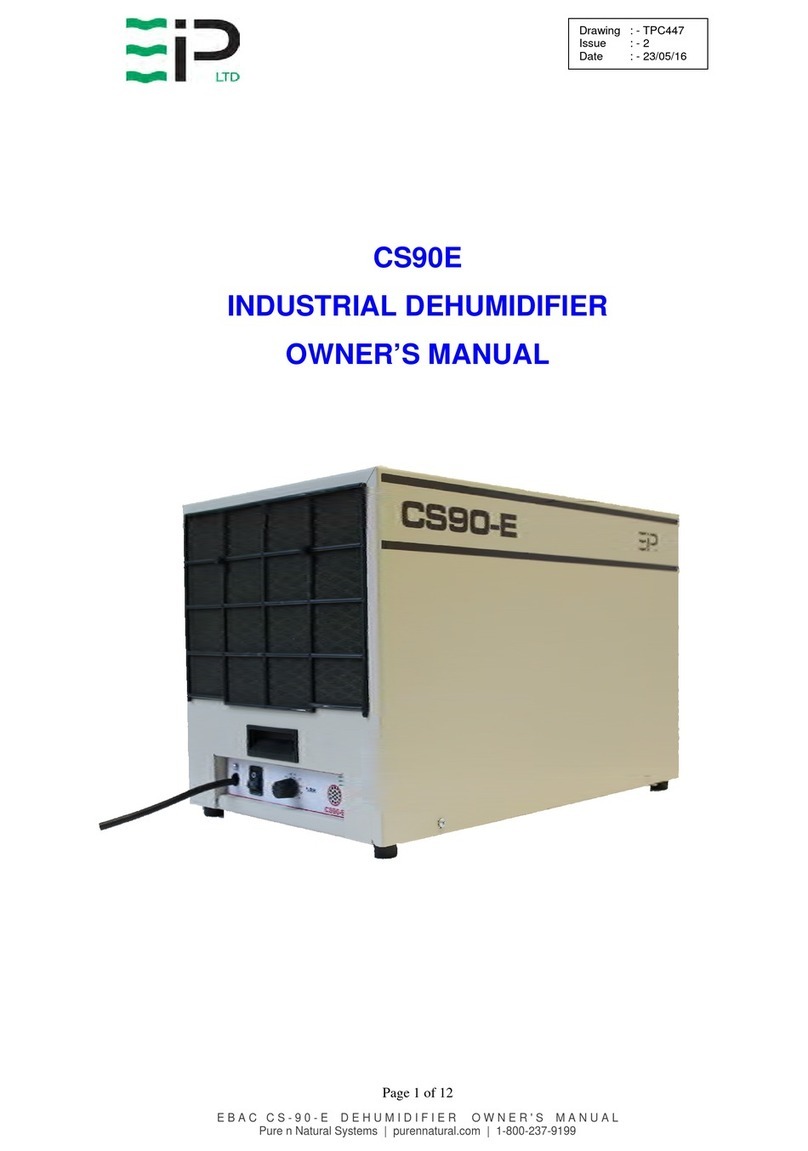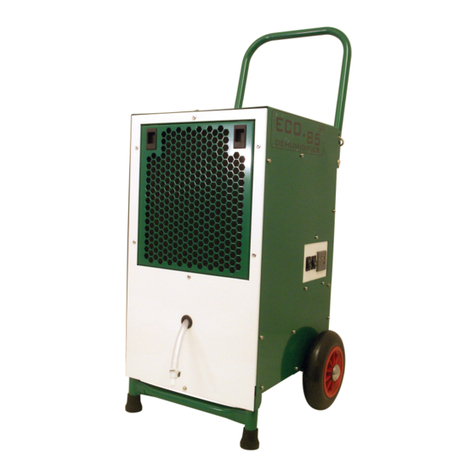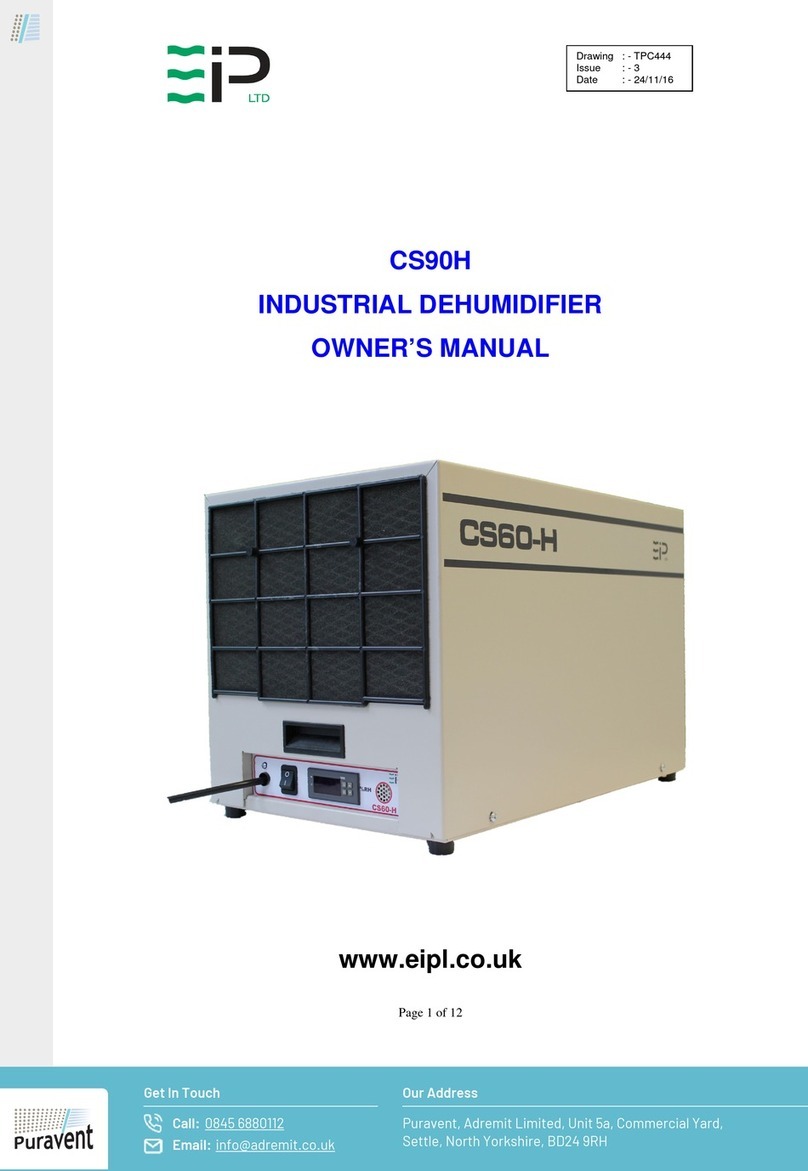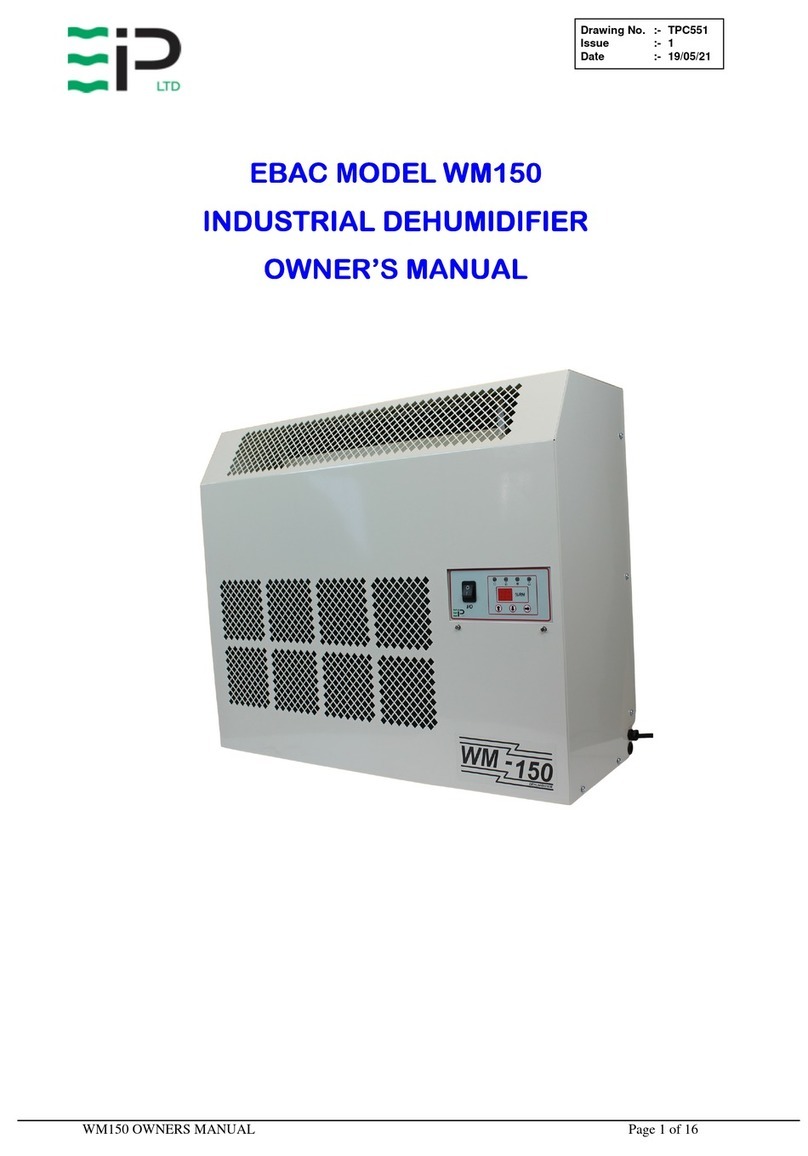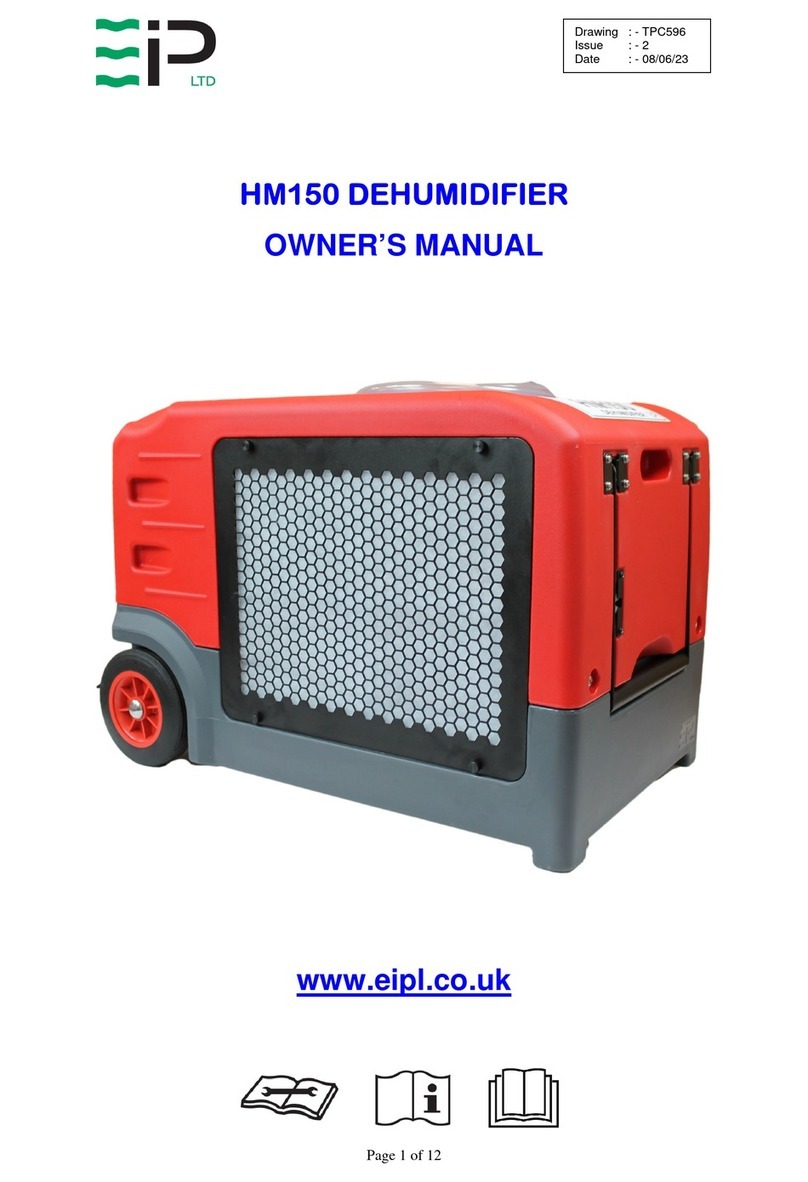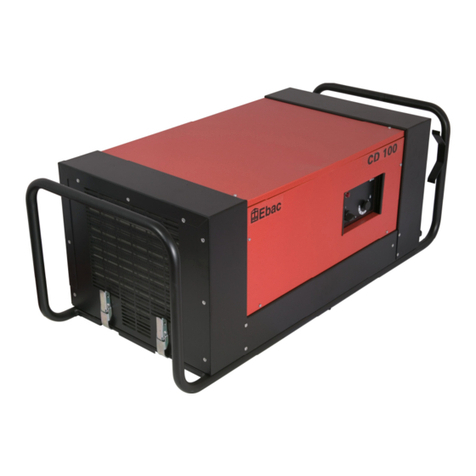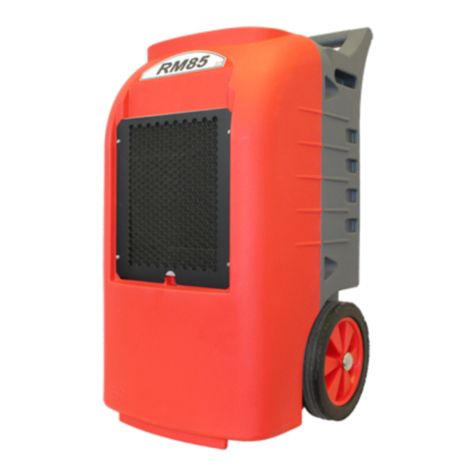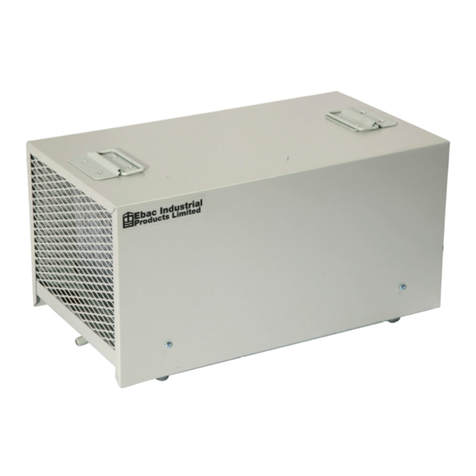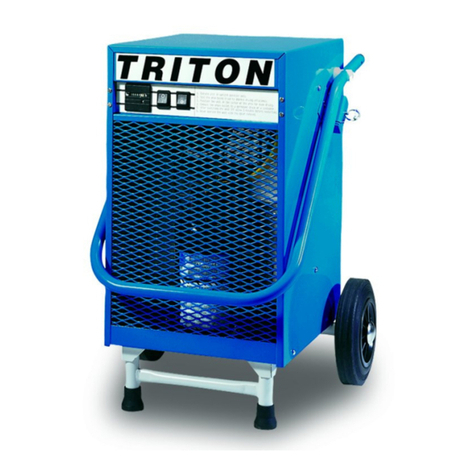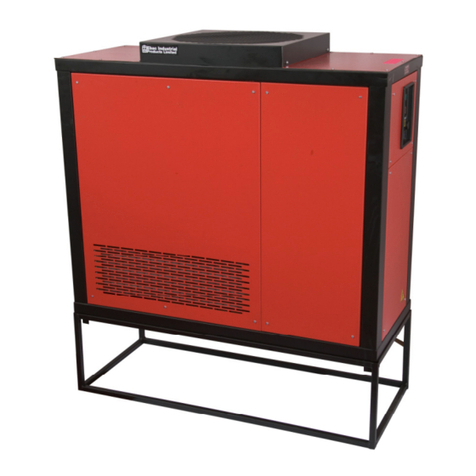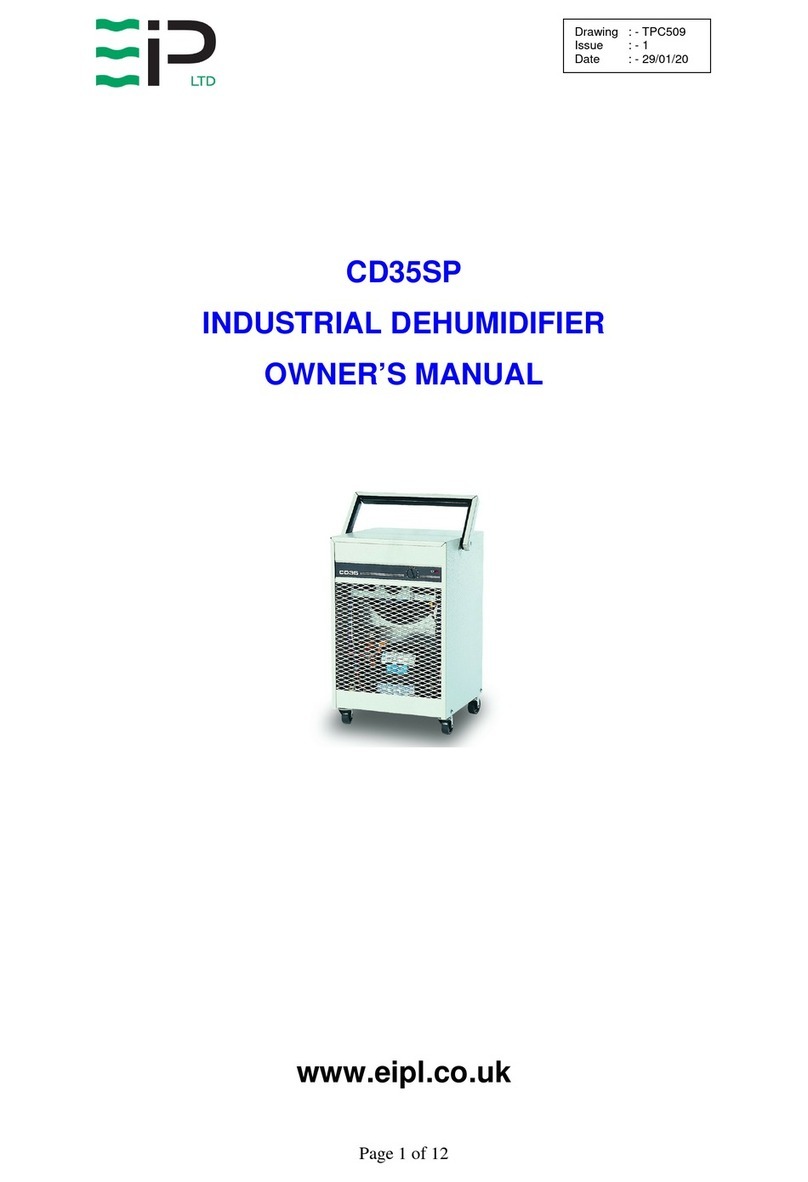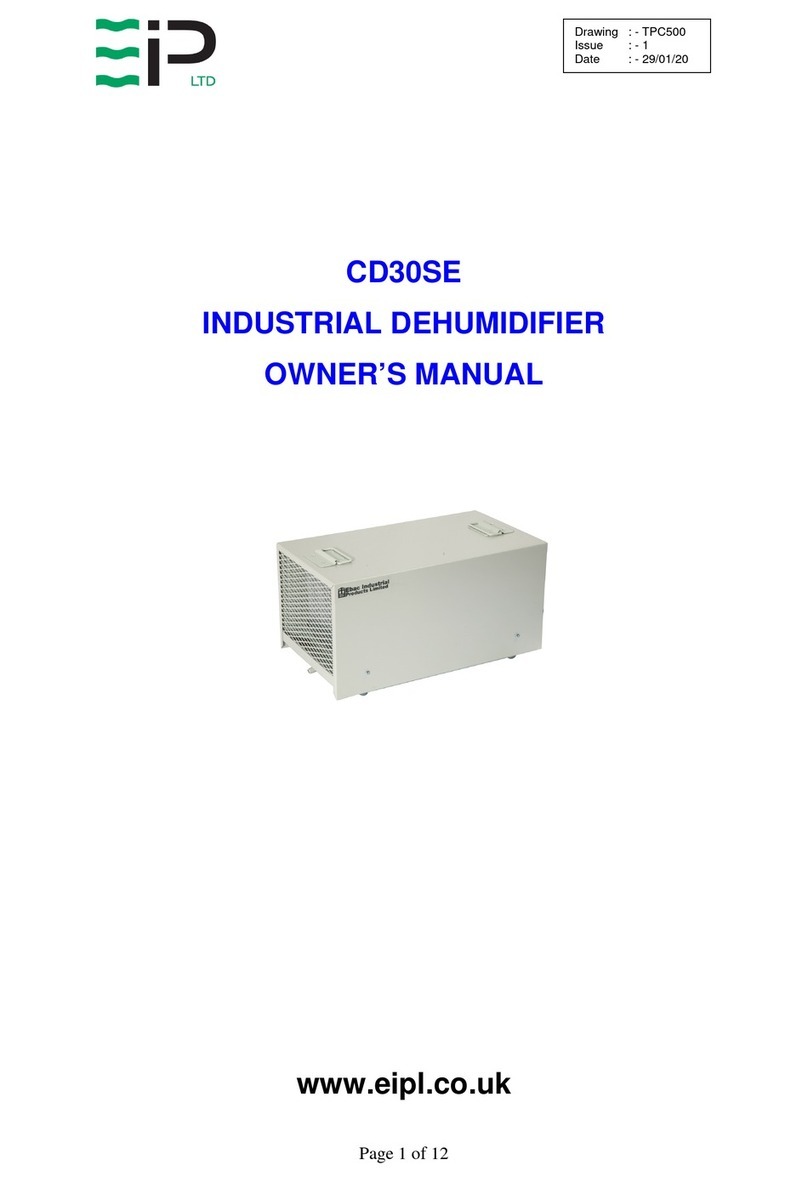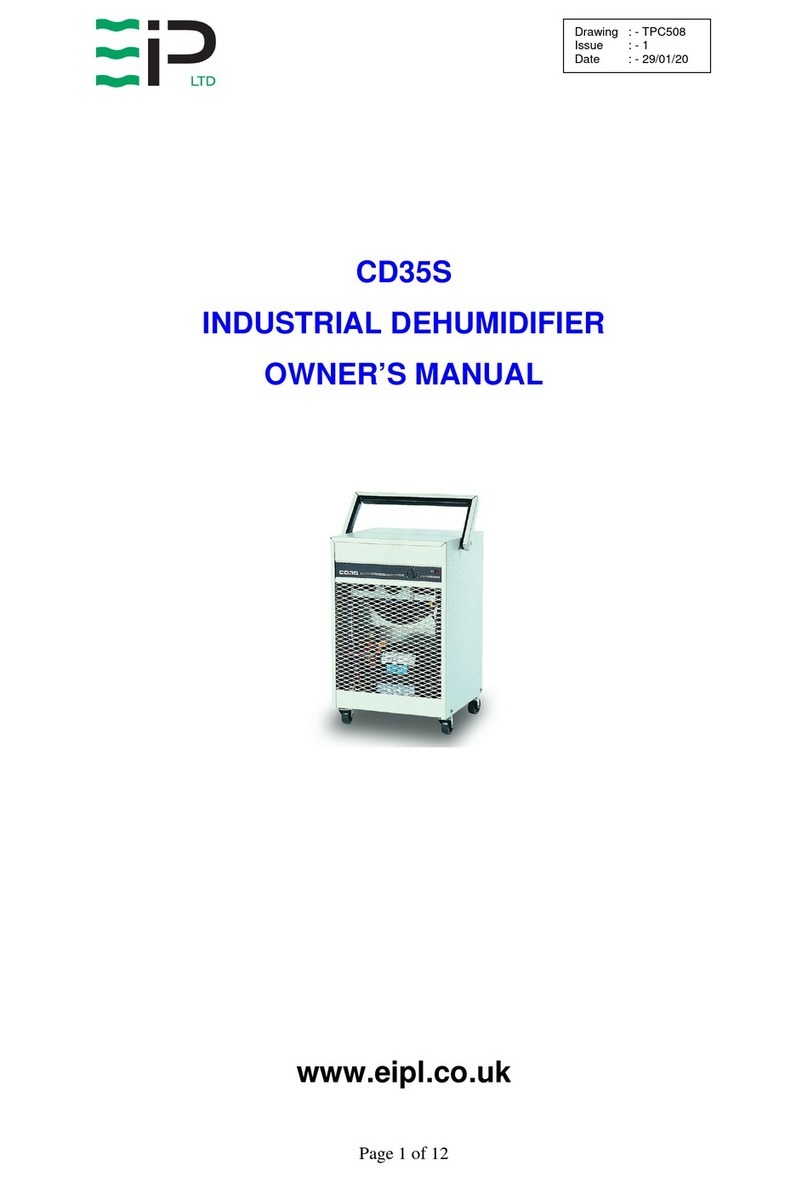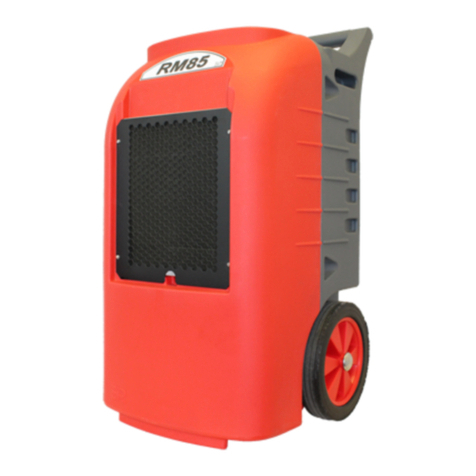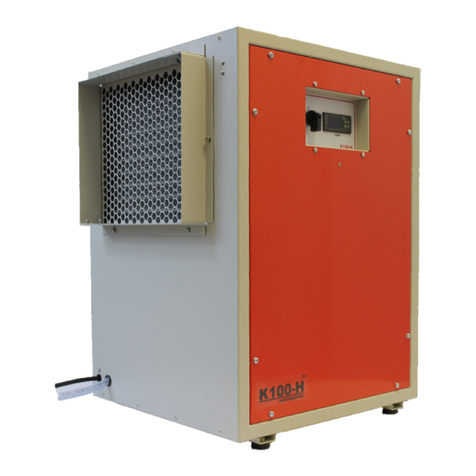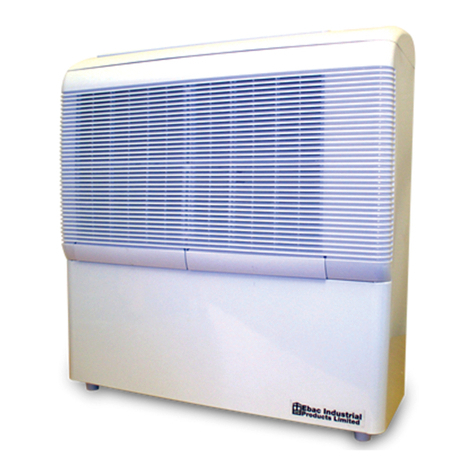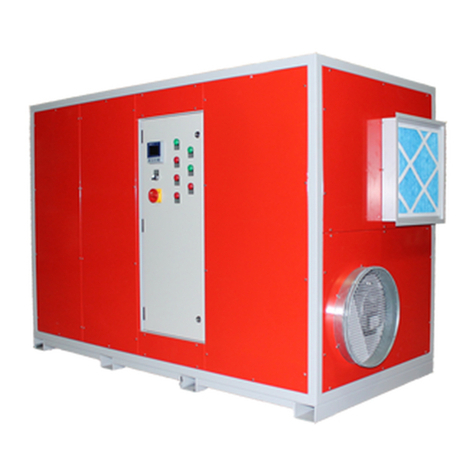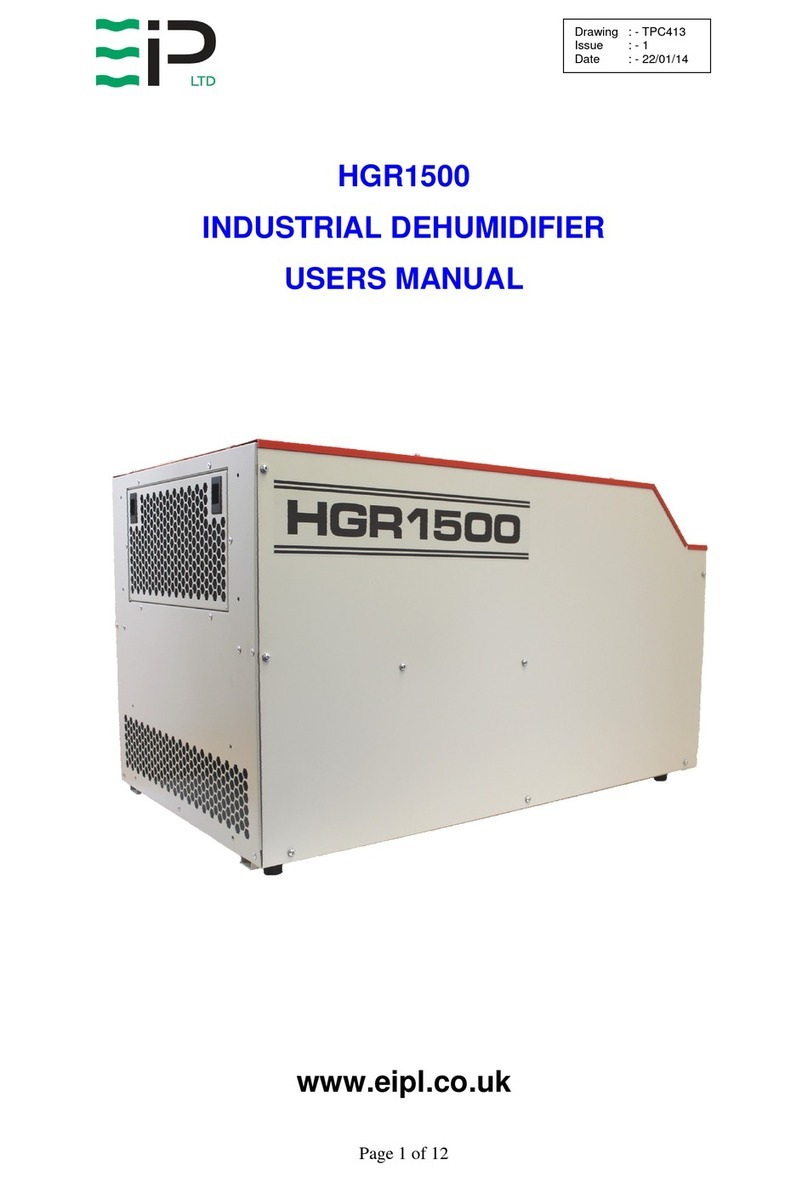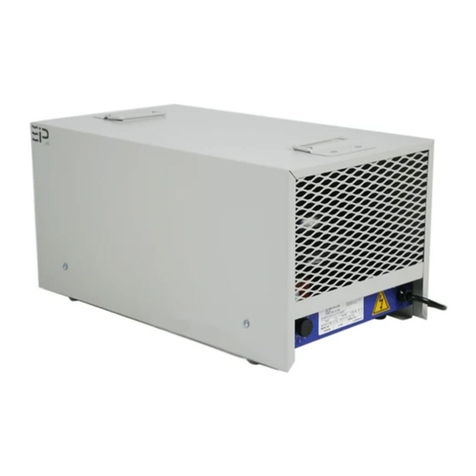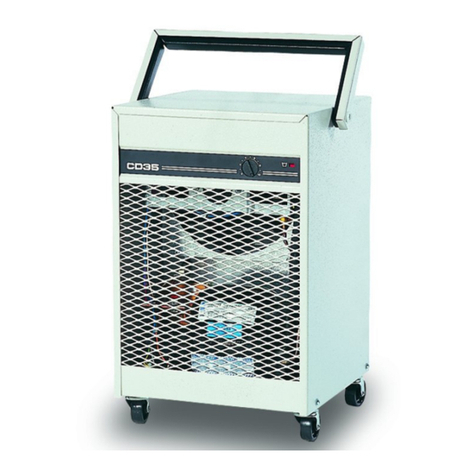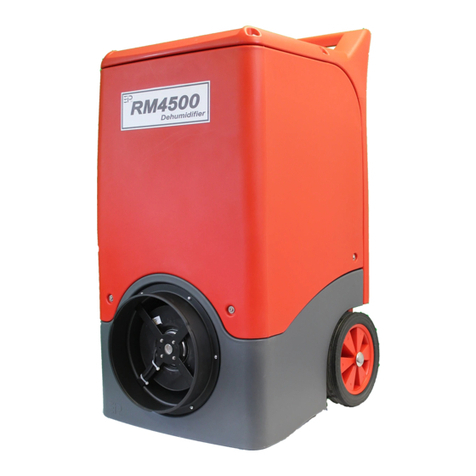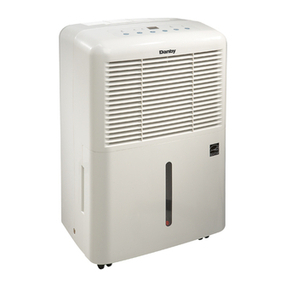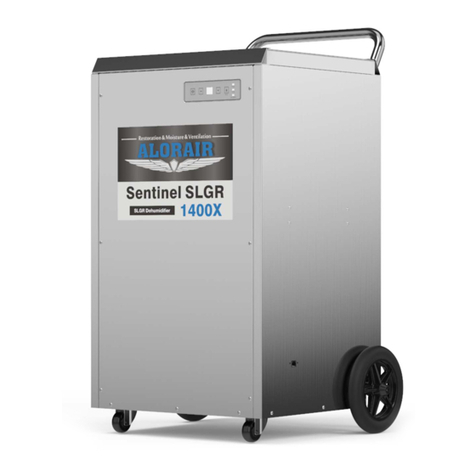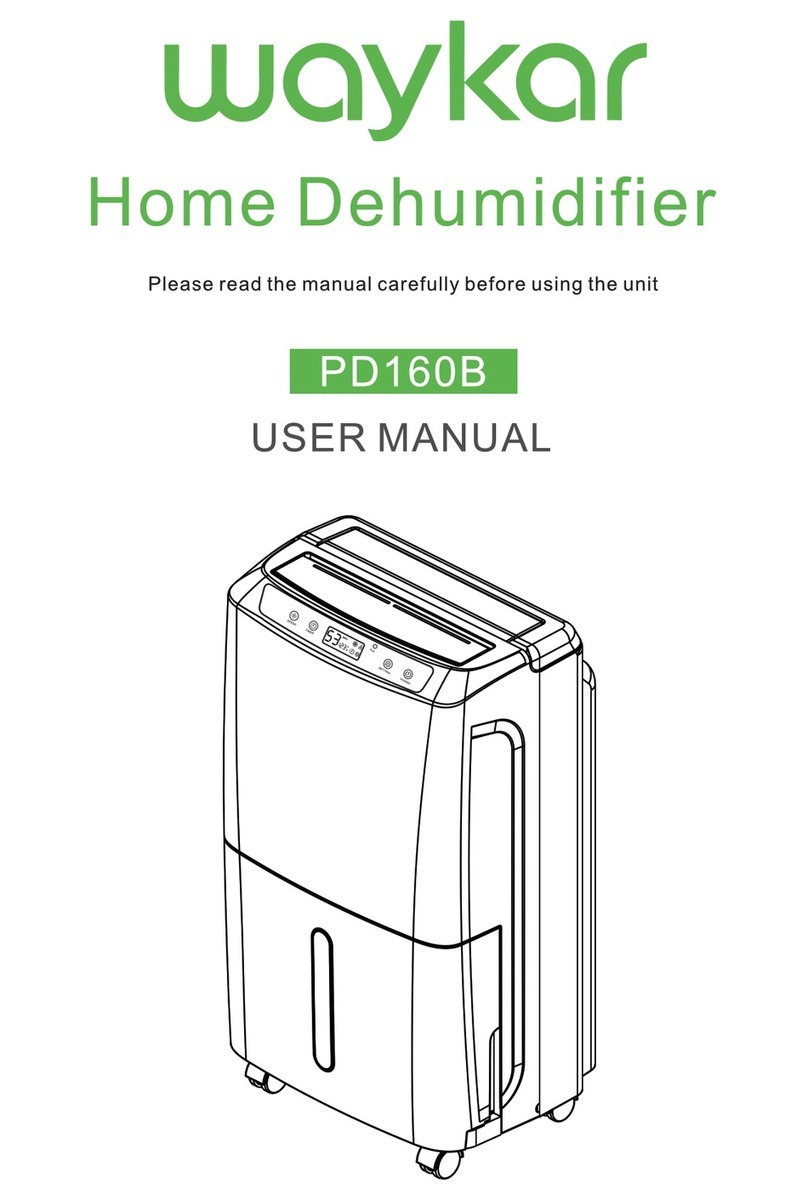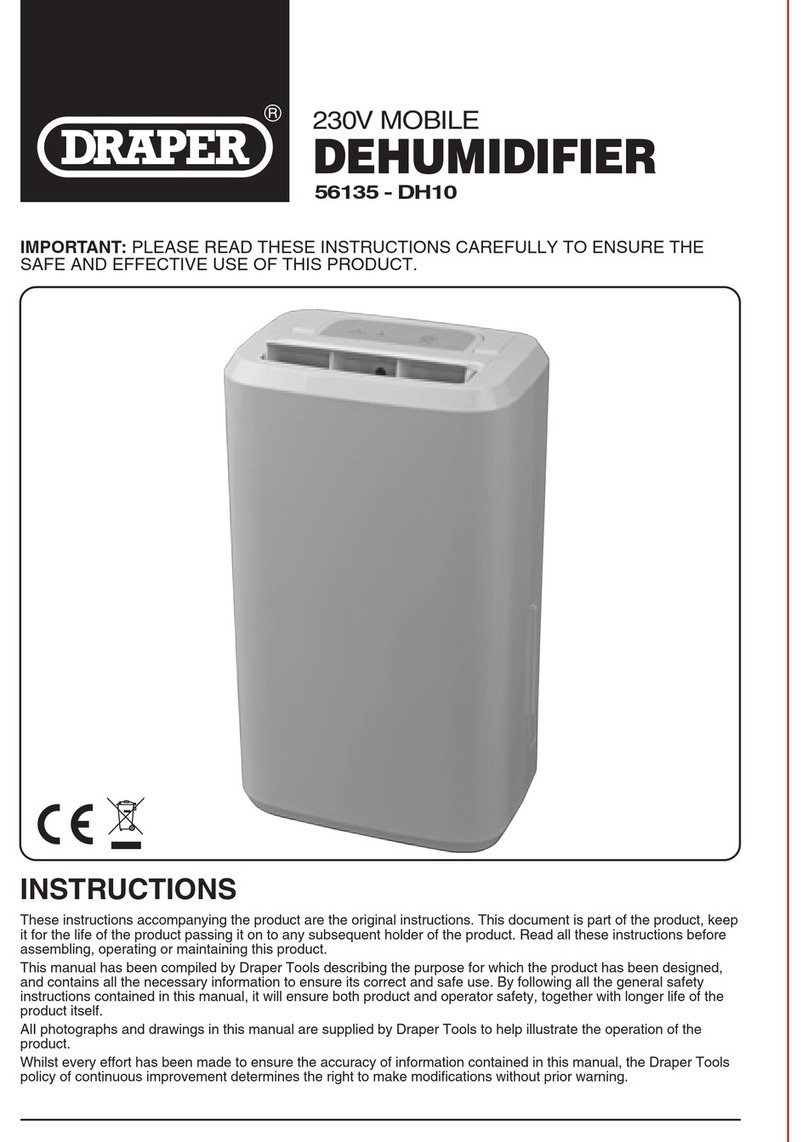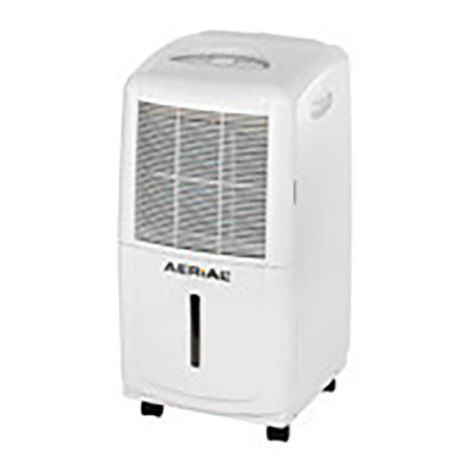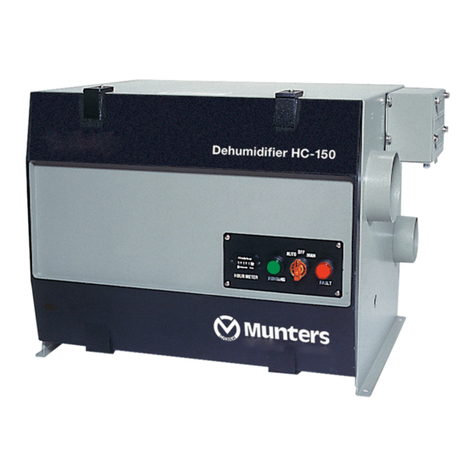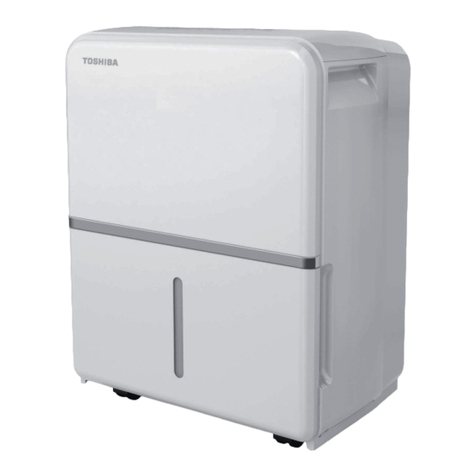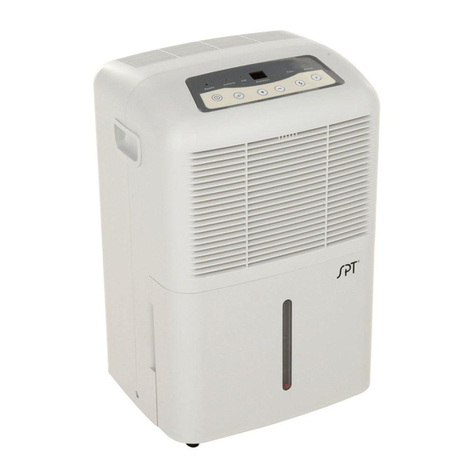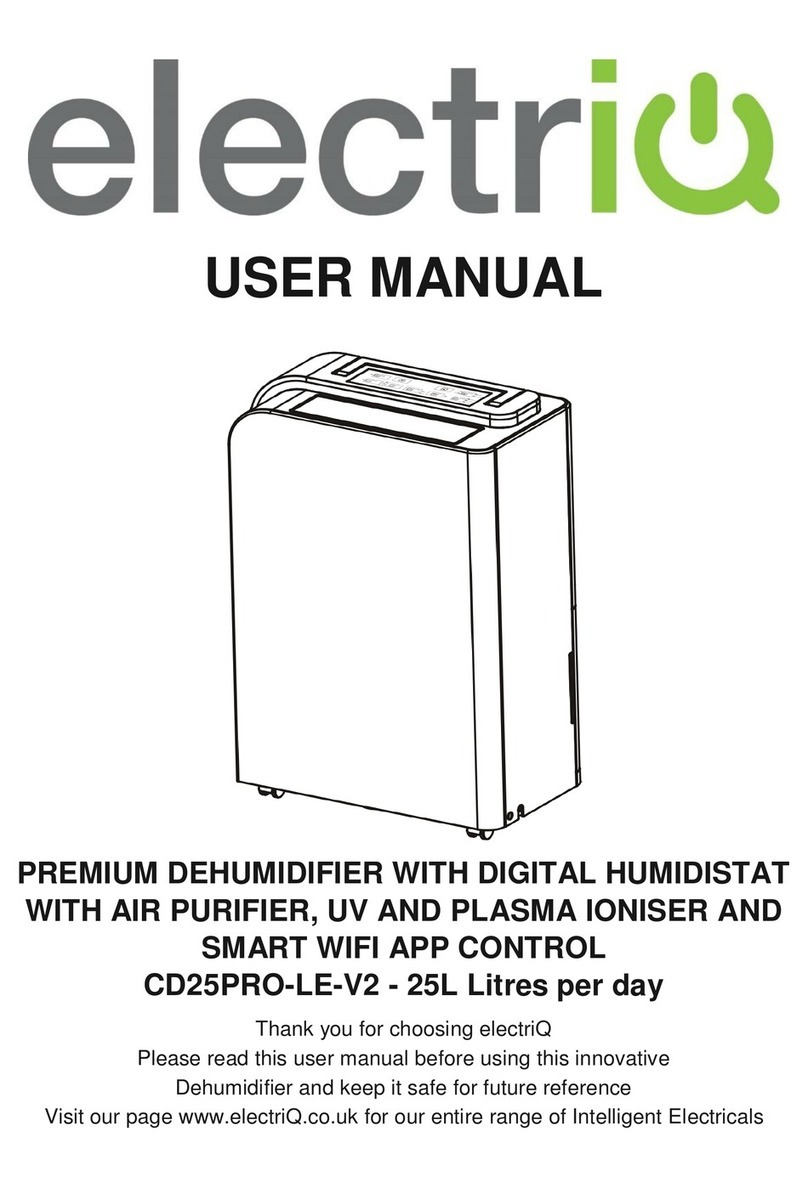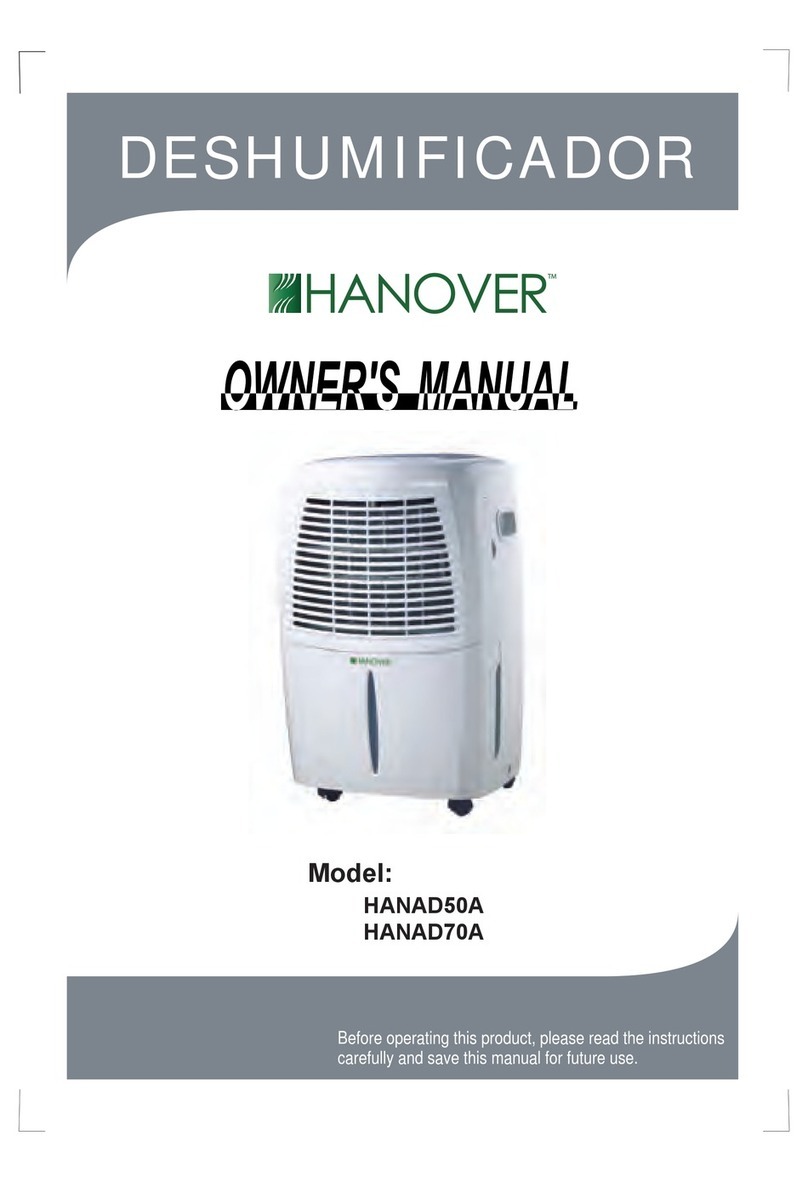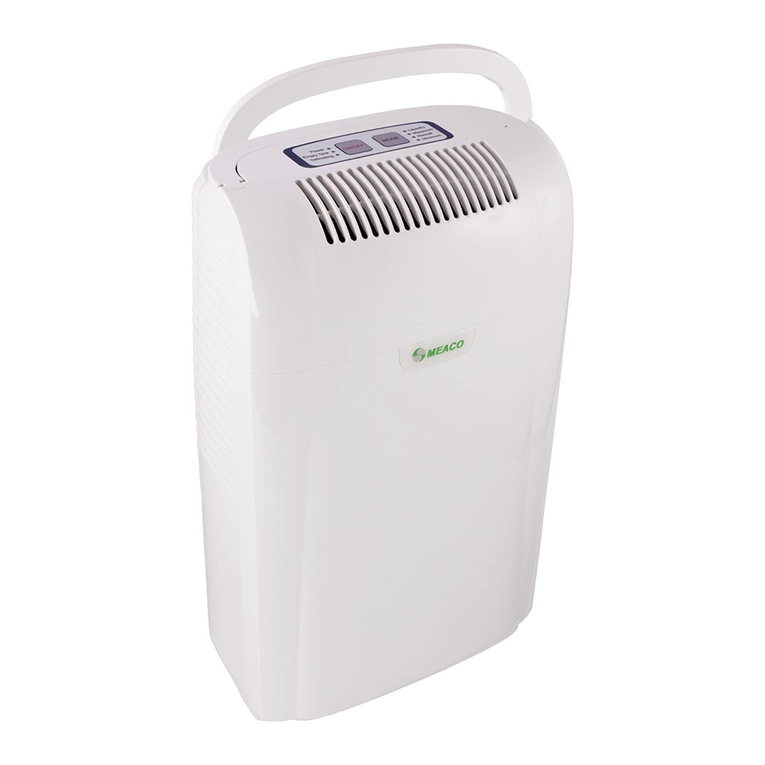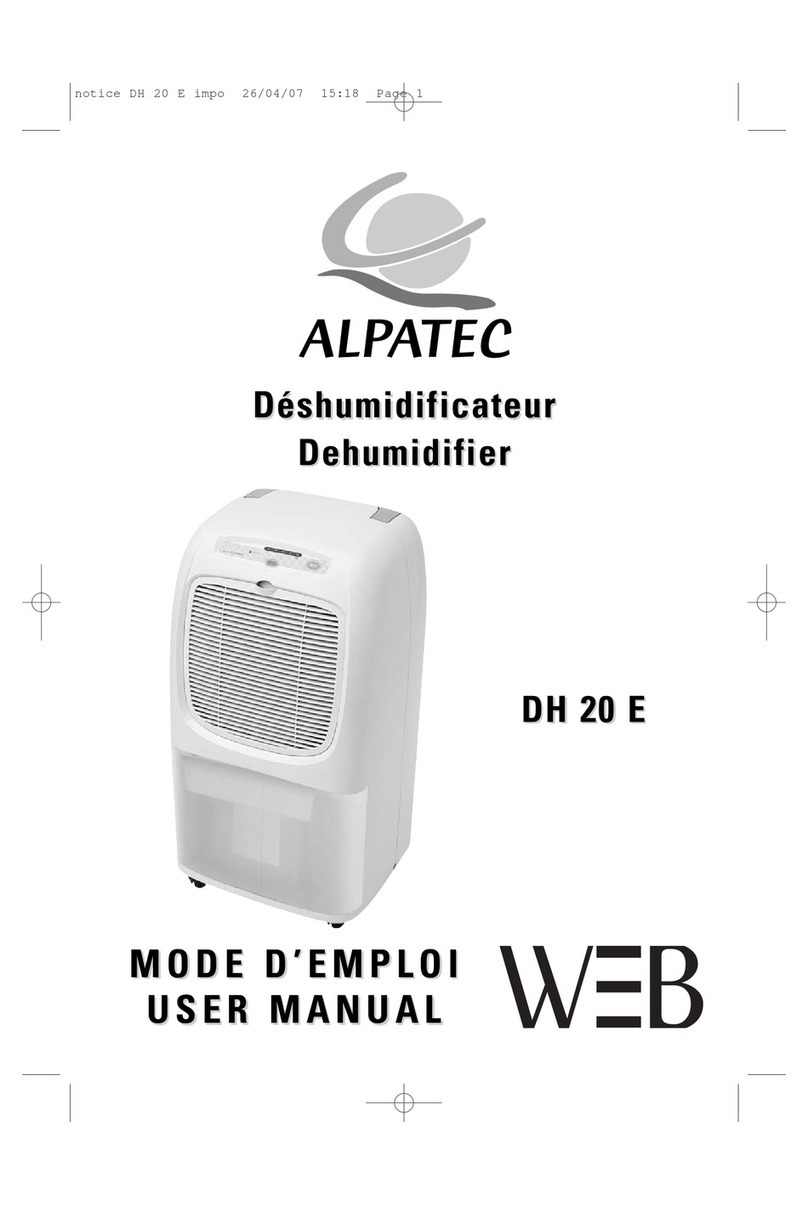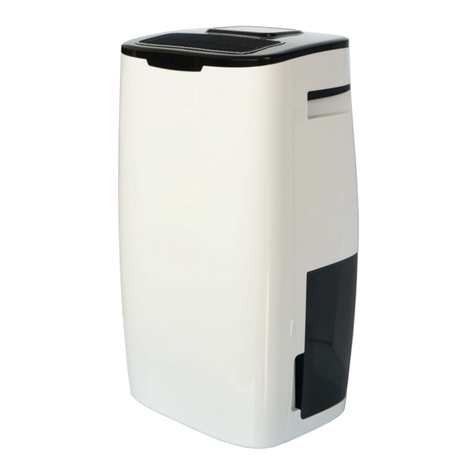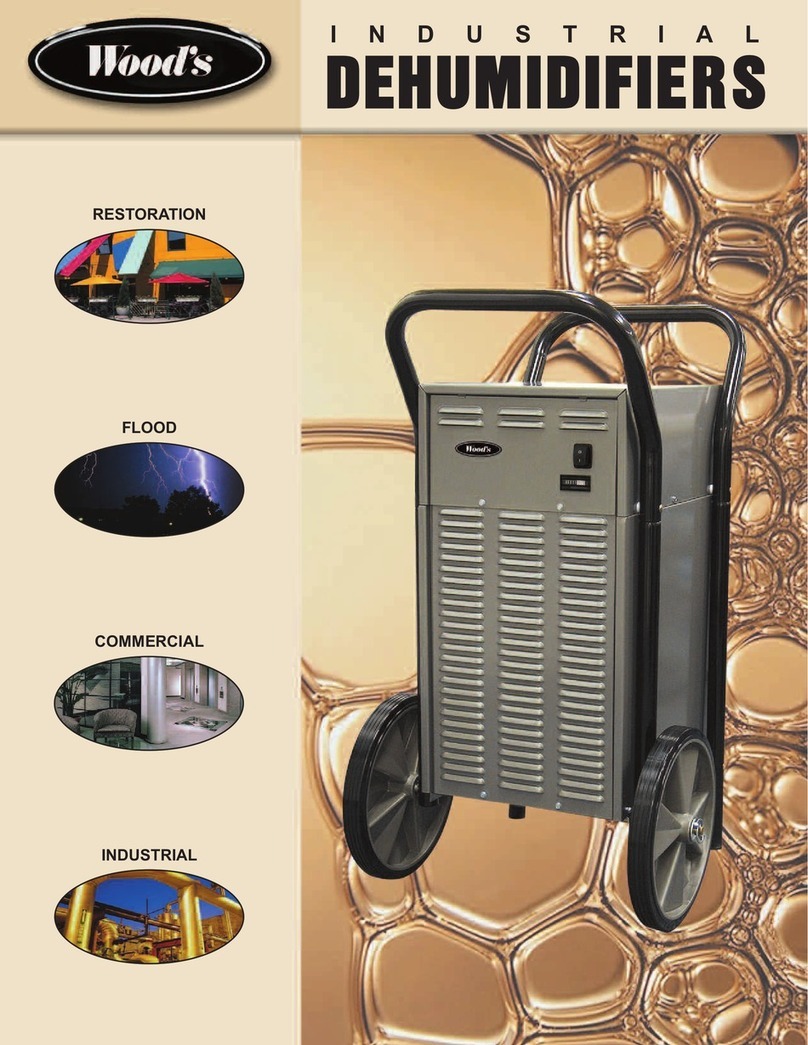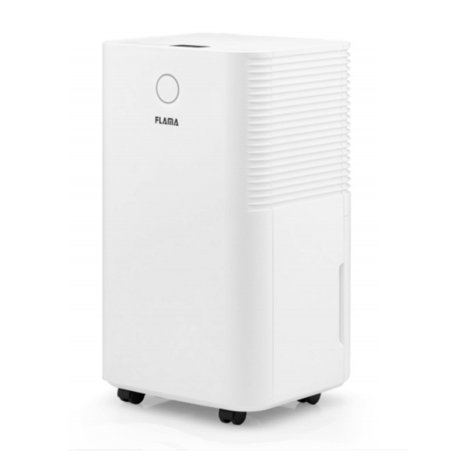EIP Ebac PP6 User manual

Page 1 of 12
Drawing : - TPC148
Issue : - 4
Date : - 24/11/16
PP6
DEHUMIDIFIER
OWNER’S MANUAL
www.eipl.co.uk

Page 2 of 12
Drawing : - TPC148
Issue : - 4
Date : - 24/11/16
UNPACKING
Carefully remove the PP6 dehumidifier unit from its transit box and visually
check for signs of transit damage. If there is evidence of damage DO NOT
attempt to operate the unit, call your supplier for advice. Do not discard the
packing; it will be useful when transporting the dehumidifier unit in the future.
INTRODUCTION
Dehumidifiers remove moisture from the air that is circulating through the unit.
The resulting reduction of relative humidity helps prevent rust, rot, mould,
mildew and condensation within the room, or other enclosed spaces where
the dehumidifier is used.
A dehumidifier consists of a motor-compressor unit, a refrigerant condenser,
an air circulating fan, a refrigerated surface, a means of collecting and
disposing the condensed moisture and a cabinet to house these components.
The fan draws air through the refrigerated surface and cools it below its dew
point, removing moisture which is collected and led away. The cool air then
passes the hot condenser, where it is reheated. With the addition of other
radiated heat the air is discharged into the room at a higher temperature but
lower relative humidity than when the air entered the unit. Continuous
circulation of the room air through the dehumidifier unit gradually reduces the
relative humidity in the room.
•The PP6 dehumidifier is a robust, compact unit designed to control the
humidity in the enclosed space in which it is placed.
•The unit is thermally protected and will switch off for a period if the
maximum operating temperature of 50ºC is exceeded.
•The PP6 has been designed for the exacting conditions, which can
prevail in the medium to long term storage of mobile shelters and
vehicles. It combines lightness and compactness with high reliability and
strength.
•Handles contribute to its portability.
•The gas which is used inside the hermetically sealed refrigeration circuit
is R134a which contains no CFC`s and has therefore a zero ozone
depletion factor. But under no circumstances should this gas be released
into the atmosphere, the unit should be serviced by trained personnel
who will reclaim any of the unwanted gas.
•A stowage plate (part no. 1012305) is available to provide secure fixing
for the PP6 dehumidifier unit under transport conditions.

Page 3 of 12
Drawing : - TPC148
Issue : - 4
Date : - 24/11/16
SPECIFICATIONS
"This product contains fluorinated greenhouse gases covered by the Kyoto Protocol. The
refrigeration system is hermetically sealed.
The Global Warming Potential (GWP) of refrigerants used in products manufactured by Ebac
Industrial Products Ltd is as follows
R134a – 1300
R407c – 1610
For type and weight of refrigerant contained in this unit, please refer to the product data label"
M
ODEL
:
PP6
H
EIGHT
:
256mm
W
IDTH
:
300mm
D
EPTH
:
470mm
W
EIGHT
:
25 Kg
A
IRFLOW
:
7 M
3
/min
P
OWER
S
UPPLY
:
230V, 1 ph, 50Hz
P
OWER
350W (max)
F
INISH
:
Epoxy coated Zintec
steel
R
EFRIGERANT
T
YPE
/Q
TY
:
R134a (175g)

Page 4 of 12
Drawing : - TPC148
Issue : - 4
Date : - 24/11/16
INSTALATION
POSITIONING:
Position the dehumidifier unit in the center of the room to be conditioned if at
all possible. However if a damp patch is particularly apparent the outlet grille
should be pointed towards it.
NOTE: Both inlet grille and outlet grille of the dehumidifier unit must have
clear space around them and not be obstructed in anyway. For correct
installation and operation the unit inlet and outlet must have a clearance of
0.5M from all adjacent surfaces and or structures.
WIRING:
Connect the power mains cable to a 5 or 13 Amp power supply. As follows:-
Brown Live
Blue Neutral
Green/Yellow Earth (ground)
DRAINAGE:
Connect a 12.5mm inside diameter hose to the condensate outlet pipe
(positioned centrally, beneath the air inlet grille). Secure the hose using a
worm drive clip. The hose should at no point be raised higher than the outlet
pipe. The hose should be ran to a permanent drain. Failure to observe this
requirement will result in flooding of the dehumidifier unit.

Page 5 of 12
Drawing : - TPC148
Issue : - 4
Date : - 24/11/16
OPERATION
The operation of the dehumidifier is to remove moisture from the air by having
it condense on the cold tubes of the evaporator coil. The air then passes over
the hot condenser coil and returns to the conditioned space slightly warmer
and dryer than when it entered the dehumidifier unit.
AIR MOVING SYSTEM:
Air is drawn in through the inlet grille at the rear of the dehumidifier (below the
handle) and over the two heat exchanges (evaporator/condenser coils) under
the influence of the axial fan, which is driven by the motor. The operation of
the fan motor is to run continuously whenever power is supplied to the
dehumidifier. The fan motor used in the dehumidifier unit is induction
protected i.e. the motor is able to take stalled current without burning out the
motor windings.
DEFROST OPERATION:
If the ambient temperature of the room in which the dehumidifier unit is
conditioning falls below 15ºC ice will form on the evaporator coil as the air is
passed over it, after a time this build up of ice on the evaporator coil will effect
the efficiency of the unit, on its ability to maintain the required set conditions
for the room.
The PP6 is therefore fitted with a defrost control device. This defrost control
device is timed to operate every 55mins, at which time, for approximately
4mins the high pressure gas is diverted by means of a by-pass valve to enter
the evaporator coil. The effect of this high pressure gas entering the
evaporator coil is to melt any build up of ice on this coil. The melted ice is
collected and disposed of by means of the condensate tube.
HIGH TEMPERATURE CUTTOUT:
The PP6 dehumidifier has been designed to work in ambient conditions of 0ºC
to +50ºC. Should the temperature in the room become excessive a thermostat
within the compressor casing will open and dehumidifying will stop, until the
thermostat resets itself.

Page 6 of 12
Drawing : - TPC148
Issue : - 4
Date : - 24/11/16
WARNING:
•Due to the high pressures within the refrigeration circuit, under no
circumstances must direct heat be applied to the evaporator coil in an
attempt to remove the build up of ice.
•No attempt should be made to cut open any part of the refrigeration circuit
due to high pressures and gas involved.
•
If the unit is switched off at the mains power supply for any reason, the unit
must be allowed to stand at rest for at least three minutes before
restarting. Failure to do so may cause the unit to blow the fuses owing to
the compressor due to there being a refrigerant imbalance.

Page 7 of 12
Drawing : - TPC148
Issue : - 4
Date : - 24/11/16
ROUTINE SERVICE
To ensure continued full efficiency of the dehumidifier, maintenance
procedures should be performed as follows:
1. Clean the surface of the evaporator and condenser coils by blowing
the dirt out from behind the fins with compressed air. Hold the
nozzle of the air hose away from the coil (approx 6”) to avoid
damaging the fins. Alternatively, vacuum clean the coils.
2. Check that the fan is firmly secured to the motor shaft and that the
fan rotates freely. The fan motor is sealed for life and therefore
does not need oiling.
3. To check the refrigerant charge, run the unit for 15 minutes and
briefly remove the cover. The evaporator coil should be evenly frost
coated across its surface. At temperatures above 25°C, the coil
may be covered with droplets of water rather than frost. Partial
frosting accompanied by frosting of the thin capillary tubes,
indicates loss of refrigerant gas or low charge.
4. Check all wiring connections.
5. To check the operation of the defrost system, switch the machine
on and leave it running for approximately 45 minutes. The machine
will then enter “Hot Gas” defrost mode for approximately 4 minutes
before returning to normal operation. If the unit will not defrost, the
printed circuit timer board may be defective or the by-pass valve
may be inoperable.
I
F ANY OF THE PRECEDING PROBLEMS OCCUR
,
CONTACT THE
E
BAC
S
ERVICE
C
ENTER PRIOR TO CONTINUED OPERATION OF THE UNIT TO
PREVENT PERMANENT DAMAGE
.
WARNING:
ENSURE THAT THE POWER CORD TO THE MACHINE HAS
BEEN DISCONNECTED BEFORE CARRYING OUT ROUTINE
SERVICE. THE SERVICING AND REPAIR OF THIS UNIT
SHOULD ONLY BE CARRIED OUT BY A SUITABLY QUALIFIED
PERSON.
WARNING:
DO NOT STEAM CLEAN REFRIGERATION COILS

Page 8 of 12
Drawing : - TPC148
Issue : - 4
Date : - 24/11/16
REPAIRS
1. Should an electrical component fail, consult the Factory Service
Center to obtain the proper replacement part.
2. If refrigerant gas is lost from the machine, it will be necessary to use
a refrigeration technician to correct the fault. Contact the Factory
Service Center prior to initiating this action.
Any competent refrigeration technician will be able to service the
equipment. The following procedure must be used:
a. The source of the leak must be determined and corrected.
b. The machine should be thoroughly evacuated before
recharging.
c. The unit must be recharged with refrigerant measured
accurately by weight.
d. For evacuation and recharging of the machine, use the crimped
and brazed charging stub attached to the side of the refrigerant
compressor.
The charging stub should be crimped and rebrazed after
servicing. N
EVER
allow permanent service valves to be fitted to
any part of the circuit. Service valves may leak causing further
loss of refrigerant gas.
3. The refrigerant compressor fitted to the dehumidifier is a durable
unit that should give many years of service. Compressor failure can
result from the machine losing its refrigerant gas. The compressor
can be replaced by a competent refrigeration technician.
Failure of the compressor can be confirmed by the following
procedure:
a. Establish that power is present at the compressor terminals
using a voltmeter.
b. With the power disconnected, check the continuity of the internal
winding by using meter across the compressor terminals. An
open circuit indicates that the compressor should be replaced.
c. Check that the compressor is not grounded by establishing that
a circuit does not exist between the compressor terminals and
the shell of the compressor.

Page 9 of 12
Drawing : - TPC148
Issue : - 4
Date : - 24/11/16
TROUBLESHOOTING
S
YMPTOM
C
AUSE
R
EMEDY
Little or no airflow
1. Loose fan on shaft
2. Fan motor burnt out
3. Dirty refrigeration coils
4. Loose electrical wiring
5. Control humidistat either
set too high or
malfunctioning
1. Tighten fan
2. Replace the fan motor
3. See Routine Maintenance
Section
4. Check the wiring diagram
to find fault and repair
5. Adjust humidistat as
required or replace
Little or no water
extraction
1. Insufficient air flow
2. Compressor fault
3. Loss of refrigerant gas
1. Check all of the above
2. Contact the Factory
Service Center
3. Contact the Factory
Service Center
Little or no defrost
when required
1. Faulty Timer
2. Faulty bypass timer
1. Contact the Factory
Service Center
2. Contact the Factory
Service Center

Page 10 of 12
Drawing : - TPC148
Issue : - 4
Date : - 24/11/16
PP6
SPARE PARTS LIST
D
ESCRIPTION
P
ART
N
UMBER
Compressor 3022131
Compressor OH Protector
3021516
Compressor Relay 3021517
Compressor Box Cover 3021518
Condenser Coil 3020740
Evaporator Coil 3014203
Filter Dryer 3020937
Fan Motor 3030194
Fan Blade 3040101
By-pass Valve 3020811
P.C.B Timer 1601900
Solenoid Coil 3030422
Drain Tube 3014338
Worm Drive Clip 3086101
Clip Nut 3080501
Mains Cable 3031225
Control Humidistat 3031528
Stowage Plate 1012305
Fastener 3087401
Washer 3087403
Spare parts available online
www.EIPLDIRECT.com

Page 11 of 12
Drawing : - TPC148
Issue : - 4
Date : - 24/11/16
WARNINGS
This appliance can be used by children from 8 years and above and persons
with reduced physical, sensory or mental capabilities or lack of experience
and knowledge if they have been given supervision or instruction concerning
use of the application in a safe way and understand the hazards involved.
Children shall not play with the appliance.
Cleaning and user maintenance shall not be made by children without
supervision.
If the SUPPLY CORD is damaged, it must be replaced by the manufacturer,
its service agent or similarly qualified person in order to avoid hazard.
This product contains fluorinated greenhouse gases covered by the Kyoto
Protocol. The refrigeration system is hermetically sealed.
The Global Warming Potential (GWP) of refrigerants used in products
manufactured by Ebac Industrial Products Ltd is as follows
R134a – 1300
R407c – 1610
For type and weight of refrigerant contained in this unit, please refer to the
product data label
Due to the high pressures within the refrigeration circuit, under no
circumstances must direct heat be applied to the evaporator coil in an attempt
to remove the build-up of ice.
No attempt should be made to cut open any part of the refrigeration circuit
due to high pressures and gas involved.
If the unit is switched off at the mains power supply for any reason, the unit
must be allowed to stand at rest for at least three minutes before restarting.

Page 12 of 12
Drawing : - TPC148
Issue : - 4
Date : - 24/11/16
UK Head Office
Ebac Industrial Products Ltd
St Helens Trading Estate
Bishop Auckland
County Durham
DL14 9AD
Tel: +44 (0) 1388 664400
Fax: +44 (0) 1388 662590
www.eipl.co.uk
American Sales Office
Ebac Industrial Products Inc
700 Thimble Shoals Blvd.
Suite 109, Newport News
Virginia, 23606-2575
USA
Tel: +01 757 873 6800
Fax: +01 757 873 3632
www.ebacusa.com
German Sales Office
Ebac Industrial Products Ltd.
Gartenfelder Str. 29-37
Gebäude 35
D-13599, Berlin
Germany
Tel: +49 3043 557241
Fax: +49 3043 557240
www.eip-ltd.de
Table of contents
Other EIP Dehumidifier manuals
